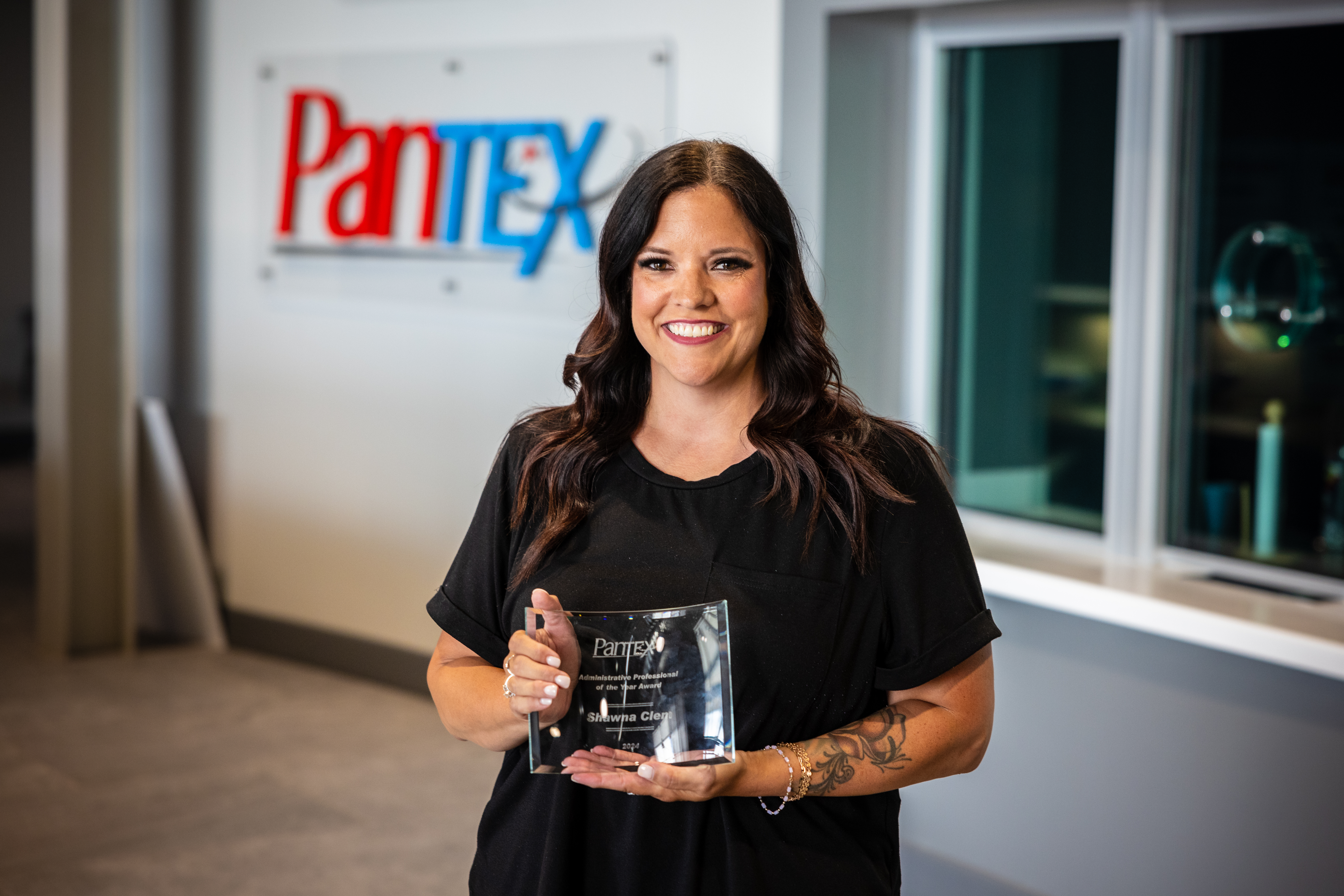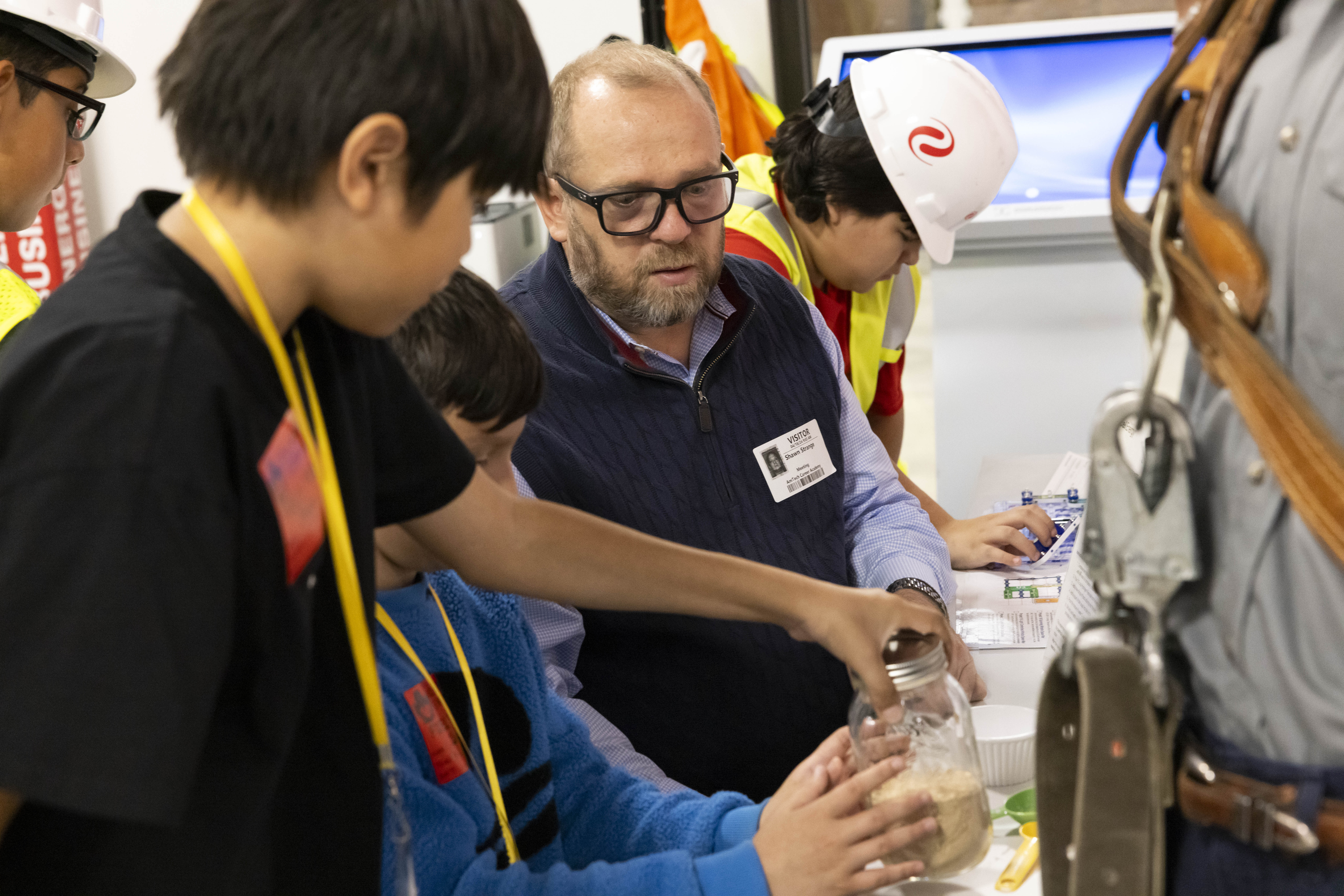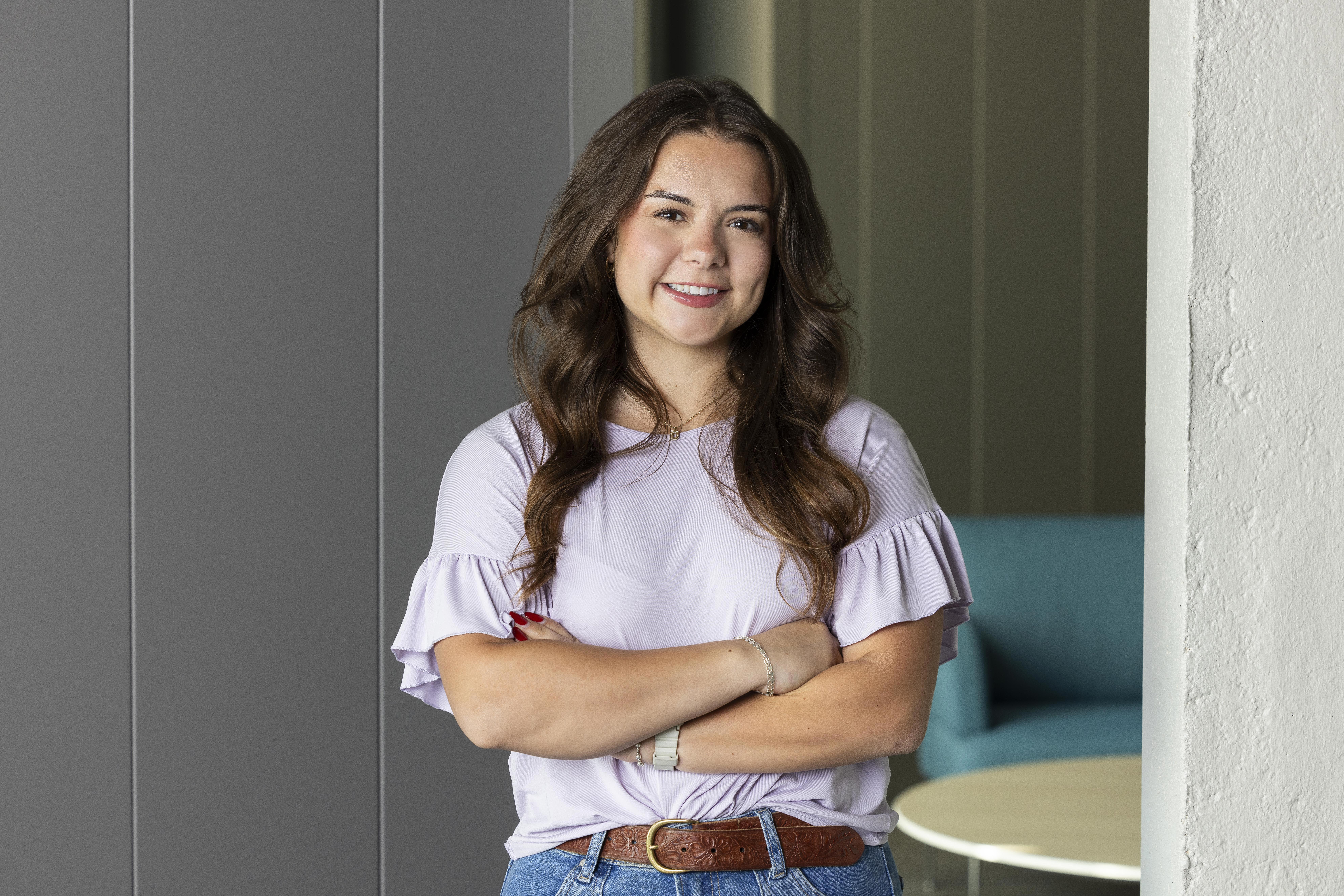Pantex Blog
Congratulations to the 2024 Pantex Administrative Assistant of the Year

Shawna Clem won the 2024 Pantex Administrative Professional of the Year Award
Every year, Pantex celebrates its administrative assistants by recognizing their achievements and contributions. Recently, one distinct administrative assistant was chosen from 100+ other nominations at the plant and has been honored as the 2024 Pantex Administrative Assistant of the Year. This year, Pantex is proud to announce that Shawna Clem, senior clerk, was chosen as the 2024 Administrative Assistant of the Year!
Clem’s supervisor, Alvin Gomez, nominated her and said, “Our department, which normally has three clerks, has been down to one: Shawna. Besides always being dependable, reliable, steady, and trustworthy, Shawna never complains––she just shows up and not only gets the work done but does so with a positive, can-do attitude every single day.”
Gomez continued, “On the challenging days, she always goes above and beyond to make sure what needs to be done is carried out in a timely and efficient manner. She truly is the ‘X’ factor.”
“I’ve always been tasked with several different assignments workwise, but my greatest one so far was when I served on the Pantex Investment Committee,” said Clem, noting how beneficial her experience on the committee was in seeing how Pantex serves the community. “Being able to serve the communities around the Panhandle and help some of the major nonprofit organizations for the surrounding communities was very beneficial as a person.”
Clem was presented with the official plaque during the Monthly Manager Meeting, where she was recognized and celebrated for her outstanding achievement.
“I would like to say ‘thank you’ to Alvin [Gomez] for always supporting me and our team,” Clem said. “Just being nominated meant a lot, but being selected honestly means everything to me.”
Pantex is appreciative for employees like Clem who demonstrate passion and hard work at their job duties every day.
“I’ve been at the plant over 2 decades and worked with so many amazing people,” stated Gomez. “Shawna stands out as one of the best…I’m thankful for her and all she does for our department; our success wouldn’t happen without her.”
From sea to shining CNS: Employees share experiences from working with a U.S. president

All Pantex and Y-12 employees have a story about how they got to CNS, but only a few can say the journey included working with a sitting U.S. president. Eight employees who had that experience shared the similarities between the two entities and detailed their duties with the commanders-in-chief.
Garcia B.
Garcia worked for the White House Communications Agency (WHCA) during three presidential terms: Obama, Trump, and Biden. As part of the communications team, he was an audiovisual technician and White House Television (WHTV) director.
Garcia said his White House experience prepared him well for his latest role at Pantex. “Being at the White House allowed me to work with people from a variety of backgrounds with varying personalities, ranging from senior staff members to interns to foreign dignitaries. Learning how to communicate effectively with personnel enabled me to adapt to the different personalities in the civilian sector,” he said.
Jeff C.
President George W. Bush was commander in chief during Jeff’s tenure as a member of the Marine Helicopter Squadron One (HMX-1), commonly known as the Presidential Helicopter Squadron.
“I served as the quality assurance (QA) chief and trip leader, where I led the QA division that ensured that HMX-1 executive flight detachment assets for presidential/chief executive and White House transport were properly inspected and maintained for maximum safety and on-call availability with a 100% mission success rate,” he said.
Jeff’s time with the squadron helped prepare him for his work at Y-12 as an engineering advisor.
“The high level of responsibility I was accustomed to for ensuring the safety and mission success of presidential support missions made transitioning into a nuclear environment much easier,” he said.
Linda F.
Linda began her career in the White House when she was 19 as a member of the White House Office of Presidential Correspondence. After 3 years, she moved to the Office of Administration and served as the administrative assistant to the deputy director of administration in the West Wing, along with President Ronald Reagan’s senior staff.
Linda said her time at the White House “was an exciting job” and instilled a very strong work ethic in her at a young age, which she’s still grateful for. “Every day brought new challenges and new solutions,” she said. “Anyone working there tried to do their very best every single day.”
She still uses the same work ethic she developed from her time at the White House as she faces new challenges every day in helping to maintain all the equipment and facilities at Y-12.
Brenda G.
Brenda also worked for WHTV. She flew on Air Force One (AF-1) during President Obama’s tenure and was tasked with recording any briefings the president might give.
“WHCA prepared me for this role [at Y-12] by perfecting my attention to detail and organization skills. There were zero errors allowed at WHCA. The world has to see and hear the president without incident. I had to ensure the right people got to the right place at the right time in order for this to happen,” she said. “At CNS, it’s the same principles and work ethic: doing the task the right way, the right time, every time.”
Joe H.
There are not many CNS employees who can say they ate chocolate chip cookies baked by Nancy Reagan, wife of President Ronald Reagan. However, Joe can make that claim, as it is one of his fondest memories working with the Reagan/George H. W. Bush administration during his time with the WHCA from 1984 to 1988.
“It was a special duty to get assigned to WHCA,” Joe said. ““I was in my early 20s, so all of this was really cool to me. I got to travel the world and work at the White House — way cool!”
Joe noted that President Reagan was just like “one of us.” There was no Wi-Fi or internet connection during this time, so Reagan enjoyed simple pleasures like walking or riding horseback on his ranch and trimming trees.
“Whether you’re military, a federal employee, or a contractor, we are all serving a greater mission,” Joe said. Pantex and Y-12 call upon employees who are dedicated to the values of supporting our nation in order to meet our nuclear deterrent mission. To Joe, that is precisely the similarity between working with a president/at the White House and for CNS — the sense of duty to support a higher calling.
Greg K.
Greg worked with the Trump and Biden administrations as part of the Presidential Support Squadron, Air Force Security Forces.
“My role was to provide direction and guidance to the Security Forces personnel and ensure the safety and security of Air Force One and its support complex,” he said.
Greg came to Pantex through the DOD SkillBridge Program.
“My previous role prepared me to work at Pantex by allowing me to understand the importance of national security, from the lowest to highest level, and has allowed me to understand Pantex’s role in ensuring the safety of the nation,” he said.
Matt P.
Matt worked at the White House during the George W. Bush and Obama administrations. He was on the travel advance team, setting up and running events globally.
“I would travel anywhere from 1 week to 3 weeks in advance of the president to coordinate and set up event sites, including sound amplification, media displays, staging, lighting, national television and radio press feeds, the president’s podium and presidential seal,” he said.
Matt also came to Y-12 through the DOD SkillBridge Program.
“The tenets of ‘A Learning Organization’ are just as applicable. ‘Set High Standards’ is one that sticks out to me,” he said. “We had a standard at the White House called ‘Presidential Quality.’ It is the best of everything, and it was the lowest standard everyone had to meet. Anything less was a failure.”
Michael V.
Michael worked as a uniformed officer with the U.S. Secret Service, where he controlled and maintained access and security for the White House, the Treasury Department, the Eisenhower Executive Office Building, and the New Executive Office Building during President Trump’s administration.
He said, “The Secret Service prepared me for Y-12 by training me to control access and maintain security. I think Y-12 and the White House are pretty comparable as far as the job goes that I perform.”
I am Mission Success: Steve Kersh

Take five minutes and learn about CNS’s Steve Kersh, Pantex meteorologist. All views and opinions are each contributor’s own and do not necessarily reflect those of CNS.
Pantex workers come from all walks of life, and a few Pantexans may be recognized by their previous jobs in the field of journalism. In case you don’t recognize him from his more than two decades as local TV chief meteorologist, please meet Steve Kersh, who joined Pantex about four years ago. His expertise in weather forecasting has cemented his place as an integral part of mission success.
“Having worked here in Amarillo for 23 years, I know how important Pantex is to our country’s mission and am excited and honored to be a part of that mission,” said Kersh. “I think I have been successful in expanding our lightning-detection systems, providing redundant systems in case another fails, and helping reduce production downtime due to weather, while maximizing the production uptime as well.”
Kersh’s expertise was an integral part of recent efforts during the wildfires that threatened the plant.
“Having a staff meteorologist of Steve Kersh’s experience and expertise is very important,” according to Senior Director of the Explosives Technology Operations, Monty Cates. “His ability to use satellite imagery paired with real time weather forecasting…was really amazing. He was able to show the emergency response organizations exactly where the fire front was despite all the smoke and was able to correctly predict how the fire would respond to changing weather conditions as it approached the site. Steve provided a clear picture of the threat and invaluable information for the emergency response teams.”
“It was a team effort that night,” Kersh noted. “I worked closely with Chief Taylor of our Pantex Fire Department to make sure that we stayed on top of the events with the Windy Deuce Fire, as the cold front approached it from the north and the shift toward Pantex became inevitable. I think we have a World Class Emergency Management Team at Pantex and I’m proud to be a very small part of it!”
Along with all his other duties, at the start of each week, Steve is asked to forecast upcoming weather events that can have a direct impact on production.
“I provide a forecast for the week’s potential production impacts due to the expected weather conditions. I’ve spoken to many different project team leads during various weather events and you feel like you are a part of what’s going on out here, even if it is simply updating them on the changing Panhandle weather!” Kersh said. “Having previously worked in a job where I set up and maintained a 207-site weather station network came in handy when our department decided to start up the Pantex StrikeNet project.”
With the StrikeNet app, meteorological information such as wind speed, wind direction, temperature, relative humidity, dew point, barometric pressure, rainfall, rainfall rate and even lightning data is now available to anyone. The StrikeNet app can be downloaded free of charge, on Google Play and the App Store.
While weather forecasters have always taken their knocks over missing weather predictions every now and then, today’s technology has made meteorology more science than guesswork.
Why are you mission success?
I am mission success because I think I have been successful in expanding our lightning detection systems, providing redundant systems in case another fails, and helping reduce production downtime due to weather, while maximizing the production uptime as well. I think it’s the “Technology-and-Innovation” that drives me to be successful.
What is your favorite aspect about your work environment?
My office in the JCDC gets VERY BUSY during any weather event. I have many Pantex employees who walk by to check the radar, chat about the weather or weekend activities that they have going on, etc. I love getting to meet my fellow Pantexans and find out about what they are doing. When severe weather is ongoing, there’s usually a crowd outside my cubicle and a lot going on.
What is one thing your coworkers would be surprised to know about you?
Many of my co-workers found a “blooper tape” from my previous job that someone posted on YouTube. I have been reminded many times of exploding studio lights during my weathercasts and several verbal miscues of mine, over the years!
What’s your favorite outside-of-work activity and why?
Storm chasing has been a fun hobby of mine, including chasing with my wife and my boys. My wife told me that she used to think that storm chasing was dangerous and just a bunch of people out “looking at storms.” She went out with me and met several other meteorologists out in various parts of the Panhandle, including a vacationing, storm-chasing Australian! She realized that there’s actually a lot of science that goes into storm chasing and I think… maybe… she enjoyed it?
Why are communications important for all Pantex and Y-12 employees?
I think communications and communicating is the MOST VITAL role at Pantex! There are so many “moving parts” here at Pantex that if you don’t communicate, problems arise quickly. I communicate with so many other departments, so many employees in various roles and with Electromagnetics Department members as well. It’s an absolute critical role in my job!
Teaching life skills and demonstrating excellence

Pantexan Shawn S. interacting with students at JA BizTown.
Balancing a budget, paying bills, taking out loans, and voting in elections are not typical tasks that you think of 5th grade students completing. The reality of these life responsibilities is exposed to Amarillo Independent School District (AISD) students through Junior Achievement (JA) BizTown, located at AmTech Career Academy.
Set up as a simulation town, JA Biztown gives elementary students experience operating banks, managing restaurants, taking out loans, voting in elections, buying cars, and more. Students are connected to real-world educational lessons through this learning experience. In addition to financial literacy, participating in this activity teaches students work and career readiness skills.
Pantex is a proud supporter of the local JA BizTown partnership with AISD. Every month during the 2023-2024 school year, more than a dozen Pantexans have volunteered their time guiding students through the simulation. When the school year ends, Pantex will have donated approximately 1,500 volunteer hours to JA BizTown.
“Our partnership with our Pantex volunteers is invaluable,” Dana W., JA of the High Plains capstone director said. “To see our Pantex volunteers teaching our students how to sound out big words, fill out a check correctly, or just simply pouring into our students that the world is their oyster is something you can’t put a price tag on. Nothing beats harder than the heart of a volunteer!”
One of those dedicated volunteers is Pantex metrology senior manager Shawn S., who can be found volunteering at his usual spot: the Xcel Energy simulation.
“My favorite memory from BizTown is seeing the lightbulb go off in the kids’ heads,” Shawn said. “I think it’s very important for Pantex to interact with our community, and BizTown is a perfect way to do that.”
Pantex’s partnership with abbr title="Amarillo Independent School District">AISD was recently recognized with the distinction of being a district “Partner in Excellence.” Pantex received this honor due to the dedicated volunteers who spent their time teaching and mentoring young students.
“Pantex is one of those outstanding partners who see the value of the work we’re doing to get our young professionals trained, skilled, and ready for the workforce,” AmTech Superintendent Jay Barrett said. “They realize that preparation begins well before high school, which is one reason why they have committed so many volunteer hours to BizTown—we could not do what we do here without them.”
In addition to Pantex’s volunteer work at BizTown, the plant also has a business feature in the simulation, complete with a replica of a wall that is found onsite in the John C. Drummond Center (JCDC).
“This partnership bolsters our need and desire to be an active partner in our communities,” Pantex Site Manager Colby Yeary said. “Attributes such as understanding a citizen’s rights and responsibilities and developing the skills necessary for successful participation in the modern working world are common among both Pantex and BizTown.”
Pantex is proud to give back to its neighbors in the Texas Panhandle and desires to take a dynamic role in helping the surrounding communities. Pantex’s partnership with BizTown and local schools is one way that Pantex employees continue to do just that: helping where they can.
Pantex deputy site manager Kenny Steward with leaders from Junior Achievement of the High Plains in front of Pantex’s feature within BizTown.
CNS intern experience leads to fulfilling careers

Darby L., who interned at Pantex in 2022 and received a job offer after graduation.
Pantex and Y-12 recently welcomed a total of 87 interns from 31 different colleges and universities across the nation. These interns will spend 10 weeks learning about the CNS sites and their missions. They will engage in intense training and learning from their host organizations, culminating in a final project that they will share at the Intern Expo on Tuesday, July 23.
Internships offer students a chance to apply abstract knowledge to form concrete experience. Because of the unique missions at Pantex and Y-12, internship experience gives these graduates an upper-hand in landing a full-time position at one of the sites. From the 2023 intern class, nearly 40% have become full-time employees, with more planning to seek a position at one of the sites after they graduate.
Darby L., who interned at Pantex in 2022 and received a job offer with Pantex Career One after graduation, said that as an Amarillo native, she grew up thinking it would be great to work at Pantex someday.
“Getting to come out to Pantex while I was still in school helped me determine if I wanted to continue working at Pantex as a full-time employee,” Darby said. “I enjoyed the friendly community of Pantex as well as the overall mission statement.”
According to Darby, one of the most important skills she learned from her internship that she still uses in her job now is the ability to communicate effectively.
“In my job, I am always meeting new people as well as learning new things,” she said. “I learned the importance of asking for help when needed as well as asking questions. I have applied the communication skills learned from my internship into my everyday tasks.”
Another former intern, Jovon H., worked at Y-12 in the summer of 2023 and is now working in Y-12 Infrastructure.
“I really enjoyed my internship. I made countless amounts of memories that will be cherished and carried with me through my life,” said Jovon. “Having the luxury of surrounding yourself with people who care about your well-being and have similar missions, goals, and ambitions that further assist you in your career development is not something you find at every company.”
Jovon said that networking was a valuable skill he took from his internship. He truly applied the saying “It’s not so much about what you know as it is who you know.”
“My internship helped me have the capacity and flexibility to build quality relationships with people,” he said. “If no one knows your name, passions, ambitions, and/or face, how can others assist or know what your ultimate goals and ambitions are as an employee?”
To the incoming interns, Darby offered this advice to help them during their internship: “I’d recommend building connections with your employers and fellow interns.”
Jovon echoed the importance of connecting with other people during an internship.
“Communicate and collaborate with each other,” he said. “Coming in, everyone is on the same playing field and is relatable. Also, seek a mentor in your organization who you look up to, and don’t be afraid to fail or ask questions.”

Pantex recently welcomed 38 summer interns from 11 different colleges and universities across the nation.
